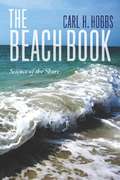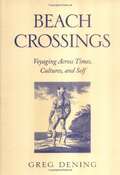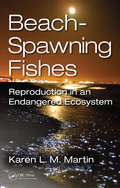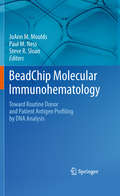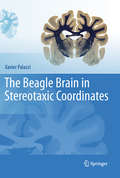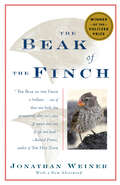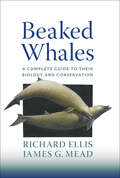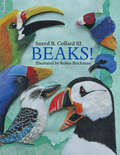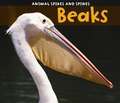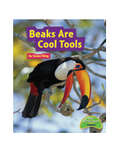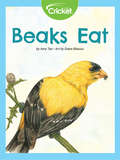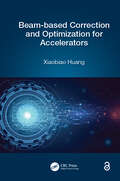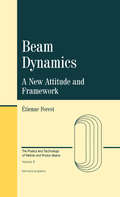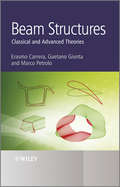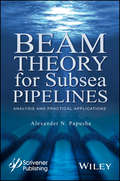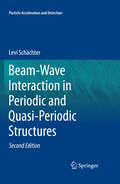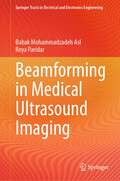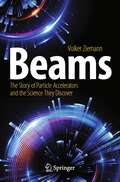- Table View
- List View
The Beach Book: Science of the Shore
by Carl HobbsWaves and tides, wind and storms, sea-level rise and shore erosion: these are the forces that shape our beaches, and beach lovers of all stripes can benefit from learning more about how these coastal processes work. With animation and clarity, The Beach Book tells sunbathers why beaches widen and narrow, and helps boaters and anglers understand why tidal inlets migrate. It gives home buyers insight into erosion rates and provides natural-resource managers and interested citizens with rich information on beach nourishment and coastal-zone development. And for all of us concerned about the long-term health of our beaches, it outlines the latest scientific information on sea-level rise and introduces ways to combat not only the erosion of beaches but also the decline of other coastal habitats. The more we learn about coastline formation and maintenance, Carl Hobbs argues, the better we can appreciate and cultivate our shores. Informed by the latest research and infused with a passion for its subject, The Beach Book provides a wide-ranging introduction to the shore, and all of us who love the beach and its associated environments will find it timely and useful.
Beach Crossings: Voyaging Across Times, Cultures, And Self
by Greg DeningDistinguished historian / anthropologist Greg Dening here revisits the island beaches of Oceania in an extended essay on first encounters and the peoples they brought together. An imaginative exploration of the symbolic strip where ocean meets island, Dening's meditation reflects upon the bloody history of the Marquesas in the South Pacific: its inhabitants and its combatants, the author's own time spent there and in study of his subject. This is a book to treasure and to reflect upon. First encounters are usually written about as the history of explorers and the anthropology of "others." It is Greg Dening's project to produce a history and anthropology of both, "on the beach," where so many of these exchanges between peoples began. Dening imaginatively reconstructs the first interactions among explorers, missionaries, and natives—mostly in the Marquesas, the primary focus of his scholarly work. He examines fictional accounts of these encounters as well as the written record, revisiting the experiences of Captain Bligh and Gauguin, Melville's seafarers as well as some famous castaways. Each featured beach crossing is prefaced with an introduction placing the encounter in its historical context. Beach Crossings is for Greg Dening a summary work, the apex of a fifty-year career that has taken him across many beaches and oceans. The author of the seminal volume Mr. Bligh's Bad Language, Dening writes here an intensely personal, compelling reflection upon his crossings, his subjects'—and ours.
Beach-Spawning Fishes: Reproduction in an Endangered Ecosystem
by Karen L.M. MartinBeach-spawning fishes from exotic locations on most continents of the world provide spectacular examples of extreme adaptations during the most vulnerable life cycle stages. The beauty, intriguing biology, and importance of these charismatic fishes at the interface of marine and terrestrial ecosystems have inspired numerous scientific studies. Adap
BeadChip Molecular Immunohematology: Toward Routine Donor and Patient Antigen Profiling by DNA Analysis
by Steve R. Sloan Paul M. Ness Joann M. MouldsThis text is a review of molecular immunohematology (MI). It draws from analyses and case studies around the world and details many techniques used in many labs. It is aimed at anyone interested in how MI is changing blood bank and transfusion medicine.
The Beagle Brain in Stereotaxic Coordinates
by Xavier PalazziThis is an up-to-date atlas of the stereotaxic coordinates of the beagle brain. It provides stellar illustrations of the organization of nerve tracts and the morphology of the nuclei that compose the central nervous system.
The Beak of the Finch: A Story of Evolution in Our Time (Pulitzer Prize Winner)
by Jonathan WeinerPULITZER PRIZE WINNER • A dramatic story of groundbreaking scientific research of Darwin's discovery of evolution that "spark[s] not just the intellect, but the imagination" (Washington Post Book World). &“Admirable and much-needed.... Weiner&’s triumph is to reveal how evolution and science work, and to let them speak clearly for themselves.&”—The New York Times Book ReviewOn a desert island in the heart of the Galapagos archipelago, where Darwin received his first inklings of the theory of evolution, two scientists, Peter and Rosemary Grant, have spent twenty years proving that Darwin did not know the strength of his own theory. For among the finches of Daphne Major, natural selection is neither rare nor slow: it is taking place by the hour, and we can watch.In this remarkable story, Jonathan Weiner follows these scientists as they watch Darwin's finches and come up with a new understanding of life itself. The Beak of the Finch is an elegantly written and compelling masterpiece of theory and explication in the tradition of Stephen Jay Gould.
Beaked Whales: A Complete Guide to Their Biology and Conservation
by Richard Ellis James G. MeadThe only book dedicated to the mysterious beaked whale, this beautiful volume combines full-color illustrations with fascinating facts.Beaked whales have been shrouded in mystery for most of the twentieth century. Denizens of deep, remote ocean waters and highly resistant to life in captivity, they have proven notoriously difficult for humans to observe. Over the past few decades, however, scientists have gained a better understanding of this distinct group of cetaceans, deciphering the natural history of the twenty-two beaked whale species. Here, famed artist and naturalist Richard Ellis and leading beaked whale researcher James G. Mead bring these elusive marine mammals into the limelight.Beaked whales’ generous life spans can extend well past 70 years. They spend their decades diving to extreme depths in search of prey, which they capture by expanding their oral cavity suddenly to suck in the squid or fish they are hunting. It appears that these sleek predators may engage in fierce, clandestine aquatic battles, as the bodies of many males are covered in scars. Because many species are only somewhat larger than dolphins, they are often confused with porpoises; however, some larger beaked whale species may grow to 40 feet. These enigmatic and compelling creatures need our help; their numbers are declining, perhaps due to the damaging effects of naval sonar on their sophisticated auditory systems.In Ellis and Mead’s book, the beaked whales finally get their due. The duo provides a combination of captivating stories about the species, original Richard Ellis art, and photos from leading natural history photographers. The result is an accessible, beautiful book—the first of its kind on this unusual group of cetaceans. Meet the beaked whales, and enjoy the fascinating and mysterious world in which they live.
Beaks!
by Sneed B. CollardHow can a toucan fly with such a large, cumbersome beak? A toucan's beak is actually light as a feather due to its honeycomb construction. And not only is it beautiful, but it's an extremely useful tool in foraging for food. Find out more fascinating facts in this remarkably illustrated study of bird beaks. Learn about several different birds, their habitats, and how their beaks are uniquely styled to help them survive. Outstanding 3-D cut-paper illustrations by Robin Brickman create amazingly realistic tableaus of birds in their natural environments with their beaks in action. Back matter includes a comprehensive quiz, a bibliography, and a list of related Web sites.
Beaks (Animal Spikes and Spines)
by Rebecca RissmanThis title introduces readers to beaks, how they help animals to survive, and how different they can look.
Beaks are Cool Tools (Fountas & Pinnell LLI Red #Level L)
by Susan RingDo birds use their beaks like people use tools? Watch a toucan pick up tiny berries with it's large beak. Or learn how a woodpecker uses it's beak to find grubs inside a tree. How does a flamingo eat under water?
Beaks, Bones and Bird Songs: How the Struggle for Survival Has Shaped Birds and Their Behavior
by Roger Lederer“Reveals the strange and wondrous adaptations birds rely on to get by.” —National Audubon Society When we see a bird flying from branch to branch happily chirping, it is easy to imagine they lead a simple life of freedom, flight, and feathers. What we don’t see is the arduous, life-threatening challenges they face at every moment. Beaks, Bones, and Bird Songs guides the reader through the myriad, and often almost miraculous, things that birds do every day to merely stay alive. Like the goldfinch, which manages extreme weather changes by doubling the density of its plumage in winter. Or urban birds, which navigate traffic through a keen understanding of posted speed limits. In engaging and accessible prose, Roger Lederer shares how and why birds use their sensory abilities to see ultraviolet, find food without seeing it, fly thousands of miles without stopping, change their songs in noisy cities, navigate by smell, and much more.
Beaks Eat
by Amy TaoHave you ever wondered why birds have beaks? They don't have hands like we do, so they need another way to help themselves. Learn all the ways birds use their beaks, and see how different birds have different types of beaks that allow them to catch their meals.
Beam-based Correction and Optimization for Accelerators
by Xiaobiao HuangThis book provides systematic coverage of the beam-based techniques that accelerator physicists use to improve the performance of large particle accelerators, including synchrotrons and linacs. It begins by discussing the basic principles of accelerators, before exploring the various error sources in accelerators and their impact on the machine's performances. The book then demonstrates the latest developments of beam-based correction techniques that can be used to address such errors and covers the new and expanding area of beam-based optimization. This book is an ideal, accessible reference book for physicists working on accelerator design and operation, and for postgraduate studying accelerator physics. Features: Entirely self-contained, exploring the theoretic background, including algorithm descriptions, and providing application guidance Accompanied by source codes of the main algorithms and sample codes online Uses real-life accelerator problems to illustrate principles, enabling readers to apply techniques to their own problems Xiaobiao Huang is an accelerator physicist at the SLAC National Accelerator Laboratory at Stanford University, USA. He graduated from Tsinghua University with a Bachelor of Science in Physics and a Bachelor of Engineering in Computer Science in 1999. He earned a PhD in Accelerator Physics from Indiana University, Bloomington, Indiana, USA, in 2005. He spent three years on thesis research work at Fermi National Accelerator Laboratory from 2003-2005. He has worked at SLAC as a staff scientist since 2006. He became Accelerator Physics Group Leader of the SPEAR3 Division, Accelerator Directorate in 2015. His research work in accelerator physics ranges from beam dynamics, accelerator design, and accelerator modelling and simulation to beam based measurements, accelerator control, and accelerator optimization. He has taught several courses at US Particle Accelerator School (USPAS), including Beam Based Diagnostics, Accelerator Physics, Advanced Accelerator Physics, and Special Topics in Accelerator Physics.
Beam Diagnostics in Superconducting Accelerating Cavities: The Extraction of Transverse Beam Position from Beam-Excited Higher Order Modes (Springer Theses)
by Pei ZhangAn energetic charged particle beam introduced to an rf cavity excites a wakefield therein. This wakefield can be decomposed into a series of higher order modes and multipoles, which for sufficiently small beam offsets are dominated by the dipole component. This work focuses on using these dipole modes to detect the beam position in third harmonic superconducting S-band cavities for light source applications. A rigorous examination of several means of analysing the beam position based on signals radiated to higher order modes ports is presented. Experimental results indicate a position resolution, based on this technique, of 20 microns over a complete module of 4 cavities. Methods are also indicated for improving the resolution and for applying this method to other cavity configurations. This work is distinguished by its clarity and potential for application to several other international facilities. The material is presented in a didactic style and is recommended both for students new to the field, and for scientists well-versed in the field of rf diagnostics.
Beam Dynamics
by Etienne ForestThis volume lays down the foundations of a theory of rings based on finite maps. The purpose of the ring is entirely discussed in terms of the global properties of the one-turn map. Proposing a theory of rings based on such maps, this work offers another perspective on storage ring theory.
Beam Propagation Method for Design of Optical Waveguide Devices
by Ginés Lifante PedrolaThe basic of the BPM technique in the frequency domain relies on treating the slowly varying envelope of the monochromatic electromagnetic field under paraxial propagation, thus allowing efficient numerical computation in terms of speed and allocated memory. In addition, the BPM based on finite differences is an easy way to implement robust and efficient computer codes. This book presents several approaches for treating the light: wide-angle, scalar approach, semivectorial treatment, and full vectorial treatment of the electromagnetic fields. Also, special topics in BPM cover the simulation of light propagation in anisotropic media, non-linear materials, electro-optic materials, and media with gain/losses, and describe how BPM can deal with strong index discontinuities or waveguide gratings, by introducing the bidirectional-BPM. BPM in the time domain is also described, and the book includes the powerful technique of finite difference time domain method, which fills the gap when the standard BPM is no longer applicable. Once the description of these numerical techniques have been detailed, the last chapter includes examples of passive, active and functional integrated photonic devices, such as waveguide reflectors, demultiplexers, polarization converters, electro-optic modulators, lasers or frequency converters. The book will help readers to understand several BPM approaches, to build their own codes, or to properly use the existing commercial software based on these numerical techniques.
Beam Structures
by Erasmo Carrera Gaetano Giunta Marco PetroloBeam theories are exploited worldwide to analyze civil, mechanical, automotive, and aerospace structures. Many beam approaches have been proposed during the last centuries by eminent scientists such as Euler, Bernoulli, Navier, Timoshenko, Vlasov, etc. Most of these models are problem dependent: they provide reliable results for a given problem, for instance a given section and cannot be applied to a different one.Beam Structures: Classical and Advanced Theories proposes a new original unified approach to beam theory that includes practically all classical and advanced models for beams and which has become established and recognised globally as the most important contribution to the field in the last quarter of a century.The Carrera Unified Formulation (CUF) has hierarchical properties, that is, the error can be reduced by increasing the number of the unknown variables. This formulation is extremely suitable for computer implementations and can deal with most typical engineering challenges. It overcomes the problem of classical formulae that require different formulas for tension, bending, shear and torsion; it can be applied to any beam geometries and loading conditions, reaching a high level of accuracy with low computational cost, and can tackle problems that in most cases are solved by employing plate/shell and 3D formulations.Key features:compares classical and modern approaches to beam theory, including classical well-known results related to Euler-Bernoulli and Timoshenko beam theoriespays particular attention to typical applications related to bridge structures, aircraft wings, helicopters and propeller bladesprovides a number of numerical examples including typical Aerospace and Civil Engineering problemsproposes many benchmark assessments to help the reader implement the CUF if they wish to do soaccompanied by a companion website hosting dedicated software MUL2 that is used to obtain the numerical solutions in the book, allowing the reader to reproduce the examples given in the book as well as to solve other problems of their own www.mul2.comResearchers of continuum mechanics of solids and structures and structural analysts in industry will find this book extremely insightful. It will also be of great interest to graduate and postgraduate students of mechanical, civil and aerospace engineering.
Beam Test Calorimeter Prototypes for the CMS Calorimeter Endcap Upgrade: Qualification, Performance Validation and Fast Generative Modelling (Springer Theses)
by Thorben QuastIn order to cope with the increased radiation level and the challenging pile-up conditions at High Luminosity-LHC, the CMS collaboration will replace its current calorimeter endcaps with the High Granularity Calorimeter (HGCAL) in the mid 2020s. This dissertation addresses two important topics related to the preparation of the HGCAL upgrade: experimental validation of its silicon- based design and fast simulation of its data. Beam tests at the DESY (Hamburg) and the CERN SPS beam test facilities in 2018 have been the basis for the design validation. The associated experimental infrastructure, the algorithms deployed in the reconstruction of the recorded data, as well as the respective analyses are reported in this thesis: First, core components of the silicon-based prototype modules are characterised and it is demonstrated that the assembled modules are functional. In particular, their efficiency to detect minimum ionising particles (MIPs) traversing the silicon sensors is found to be more than 98% for most of the modules. No indication of charge sharing between the silicon pads is observed. Subsequently, the energy response is calibrated in situ using the beam test data. Equalisation of the different responses among the readout channels is achieved with MIPs hereby deploying the HGCAL prototype as a MIP-tracking device. The relative variation of the inferred calibration constants amounts to 3% for channels on the same readout chip. The calibration of the time-of-arrival information is performed with an external time reference detector. With it, timing resolutions of single cells including the full prototype readout chain around 60ps in the asymptotic high energy limit are obtained. The calorimetric performance of the HGCAL prototype is validated with particle showers induced by incident positrons and charged pions. For electromagnetic showers, the constant term in the relative energy resolution is measured to be (0.52± 0.08) %, whereas the stochastic term amounts to (22.2 ± 0.3)% √GeV. This result is in good agreement with the calorimeter simulation with GEANT4. The prototype’s positioning resolution of the shower axis, after subtracting the contribution from the delay wire chambers in the beam line used as reference, is found to be below 0.4 mm at 300 GeV. At the same energy, the angular resolution in the reconstruction of the electromagnetic shower axis in this prototype is measured to be less than 5mrad. The analysis of the hadronic showers in this thesis makes use state-of-the- art machine-learning methods that exploit the calorimeter’s granularity. It is indicated that the energy resolution may be improved using software compensation and also that the separation of electromagnetic and charged pion-induced showers in the calorimeter may benefit from such methods. The measurements of the hadronic showers are adequately reproduced by GEANT4 simulation. Altogether, the obtained results from the analysis of the beam test data in this thesis are in agreement with the full functionality of the silicon-based HGCAL design. The final part of this thesis provides a proof of principle that generative modelling based on deep neural networks in conjunction with the Wasserstein distance is a suitable approach for the fast simulation of HGCAL data: Instead of sequential simulation, a deep neural network-based generative model generates all calorimeter energy depositions simultaneously. This genera t or network is optimised throu gh an adversarial training process using a critic network guided by the Wasserstein distance. The developed framework in this thesis is applied to both GEANT4- simulated electromagnetic showers and to positron data from the beam tests. Ultimately, this fast simulation approach is up to four orders of magnitude faster than sequential simulation with GEANT4. It is able to produce realistic calorimeter energy depositions from electromagnetic showers, incorporating their fluctuations and correlations when converted into typical calorimeter observables.
Beam Theory for Subsea Pipelines- Analysis and Practical Applications
by Alexander N. PapushaIntroducing a new practical approach within the field of applied mechanics developed to solve beam strength and bending problems using classical beam theory and beam modeling, this outstanding new volume offers the engineer, scientist, or student a revolutionary new approach to subsea pipeline design. Integrating use of the Mathematica program into these models and designs, the engineer can utilize this unique approach to build stronger, more efficient and less costly subsea pipelines, a very important phase of the world's energy infrastructure. Significant advances have been achieved in implementation of the applied beam theory in various engineering design technologies over the last few decades, and the implementation of this theory also takes an important place within the practical area of re-qualification and reassessment for onshore and offshore pipeline engineering. A general strategy of applying beam theory into the design procedure of subsea pipelines has been developed and already incorporated into the ISO guidelines for reliability-based limit state design of pipelines. This work is founded on these significant advances. The intention of the book is to provide the theory, research, and practical applications that can be used for educational purposes by personnel working in offshore pipeline integrity and engineering students. A must-have for the veteran engineer and student alike, this volume is an important new advancement in the energy industry, a strong link in the chain of the world's energy production.
Beam-Wave Interaction in Periodic and Quasi-Periodic Structures: Beam-wave Interaction In Periodic And Quasi-periodic Structures (Particle Acceleration and Detection)
by Levi SchächterThe main theme of this book is the interaction of electrons with electromagnetic waves in the presence of periodic and quasi-periodic structures in vacuum, in view of applications in the design and operation of particle accelerators. The first part of the book is concerned with the textbook-like presentation of the basic material, in particular reviewing elementary electromagnetic phenomena and electron dynamics. The second part of the book describes the current models for beam-wave interactions with periodic and quasi-periodic structures. This is the basis for introducing, in the last part of the book, a number of particle and radiation sources that rest on these principles, in particular the free-electron laser, wake-field acceleration schemes and a number of other advanced particle accelerator concepts. This second edition brings this fundamental text up-to-date in view of the enormous advances that have been made over the last decade since the first edition was published. All chapters, as well as the bibliography, have been significantly revised and extended, and the number of end-of-chapter exercises has been further increased to enhance this book's usefulness for teaching specialized graduate courses.
Beamforming in Medical Ultrasound Imaging (Springer Tracts in Electrical and Electronics Engineering)
by Babak Mohammadzadeh Asl Roya ParidarThis book deals with the concept of medical ultrasound imaging and discusses array signal processing in ultrasound. Signal processing using different beamforming techniques in order to achieve a desirable reconstructed image and, consequently, obtain useful information about the imaging medium is the main focus of this book. In this regard, the principles of image reconstruction techniques in ultrasound imaging are fully described, and the required processing steps are completely expanded and analyzed in detail. Simulation results to compare the performance of different beamformers are also included in this book to visualize their differences to the reader. Other advanced techniques in the field of medical ultrasound data processing, as well as their corresponding recent achievements, are also presented in this book. Simply put, in this book, processing of medical ultrasound data from different aspects and acquiring information from them in different manners are covered and organized in different chapters. Before going through the detailed explanation in each chapter, it gives the reader an overview of the considered issue and focuses his\her mind on the challenge ahead. The contents of the book are also presented in such a way that they are easy for the reader to understand. This book is recommended for researchers who study medical ultrasound data processing.
Beams: The Story of Particle Accelerators and the Science They Discover (Copernicus Books)
by Volker ZiemannThis book describes and explains the world of particle accelerators and the physics they study. The presentation is non-technical (E=mc2 is the only equation!) and the prose accessible. By following the co-evolution of particle accelerators and particle physics, readers will learn why the accelerators are built, how they work, and what "results" they produce. The book highlights the great ideas (e.g. synchrotron) and technological advances (superconducting magnets) that boosted the potential of accelerators and led to new discoveries, eventually resulting in the standard model of particle physics. Many concepts are illustrated with figures derived from three-dimensional models; these include theaccelerators, detectors, and particles. Background information about the main protagonists, along with pointers to further reading, e.g. from "Scientific American," are provided in endnotes.
Beam's Eye View Imaging in Radiation Oncology (Imaging in Medical Diagnosis and Therapy)
by Ross I. BerbecoThis first dedicated overview for beam’s eye view (BEV) covers instrumentation, methods, and clinical use of this exciting technology, which enables real-time anatomical imaging. It highlights how the information collected (e.g., the shape and size of the beam aperture and intensity of the beam) is used in the clinic for treatment verification, adaptive radiotherapy, and in-treatment interventions. The chapters cover detector construction and components, common imaging procedures, and state of the art applications. The reader will also be presented with emerging innovations, including target modifications, real-time tracking, reconstructing delivered dose, and in vivo portal dosimetry. Ross I. Berbeco, PhD, is a board-certified medical physicist and Associate Professor of Radiation Oncology at the Dana-Farber Cancer Institute, Brigham and Women’s Hospital and Harvard Medical School.
Beamtimes and Lifetimes: The World of High Energy Physicists
by Sharon TraweekThe unique breed of particle physicists constitutes a community of sophisticated mythmakers--explicators of the nature of matter who forever alter our views of space and time. But who are these people? What is their world really like? Sharon Traweek, a bold and original observer of culture, opens the door to this unusual domain and offers us a glimpse into the inner sanctum.
A Bear Far from Home
by Susan FletcherThis poignant historical nonfiction book, about a polar bear that was gifted to King Henry III, beautifully shows the importance of respecting our natural world and its precious animals.Long ago, when kings and queens ruled much of the world, the king of Norway gave the king of England a bear. Imagine a polar bear at ease in her natural arctic world, her only home--until trappers capture her and take her to the king of England.Imagine a polar bear in her lonely new world, stuck in a cage. This small, enclosed space is her only home--until King Henry III decrees that she be brought to the Thames River every day to swim and fish.Imagine now this same polar bear dipping a curious paw in the river water, then leaping in with a joyful splash. And it is here, in this unfamiliar, faraway land, in one small way, that she finds home once again.
